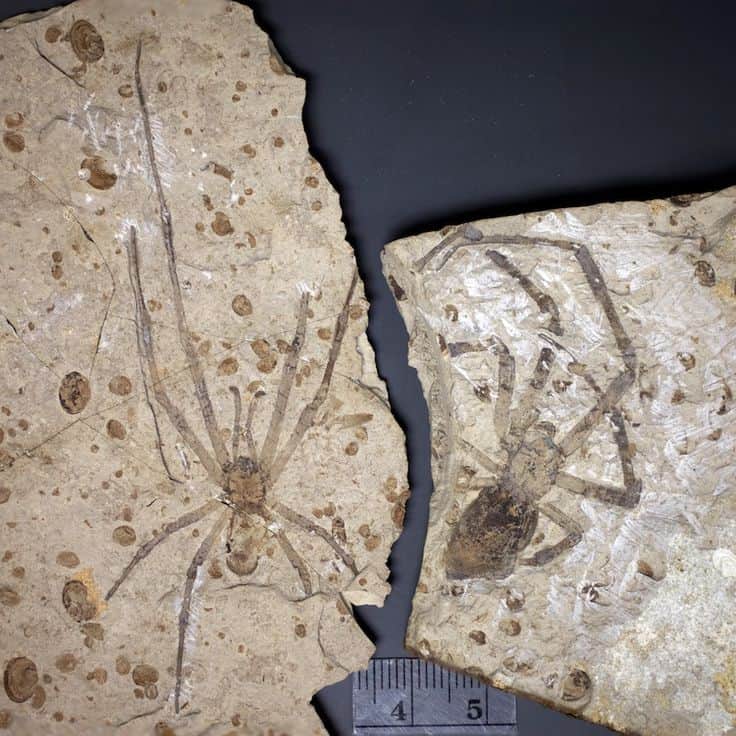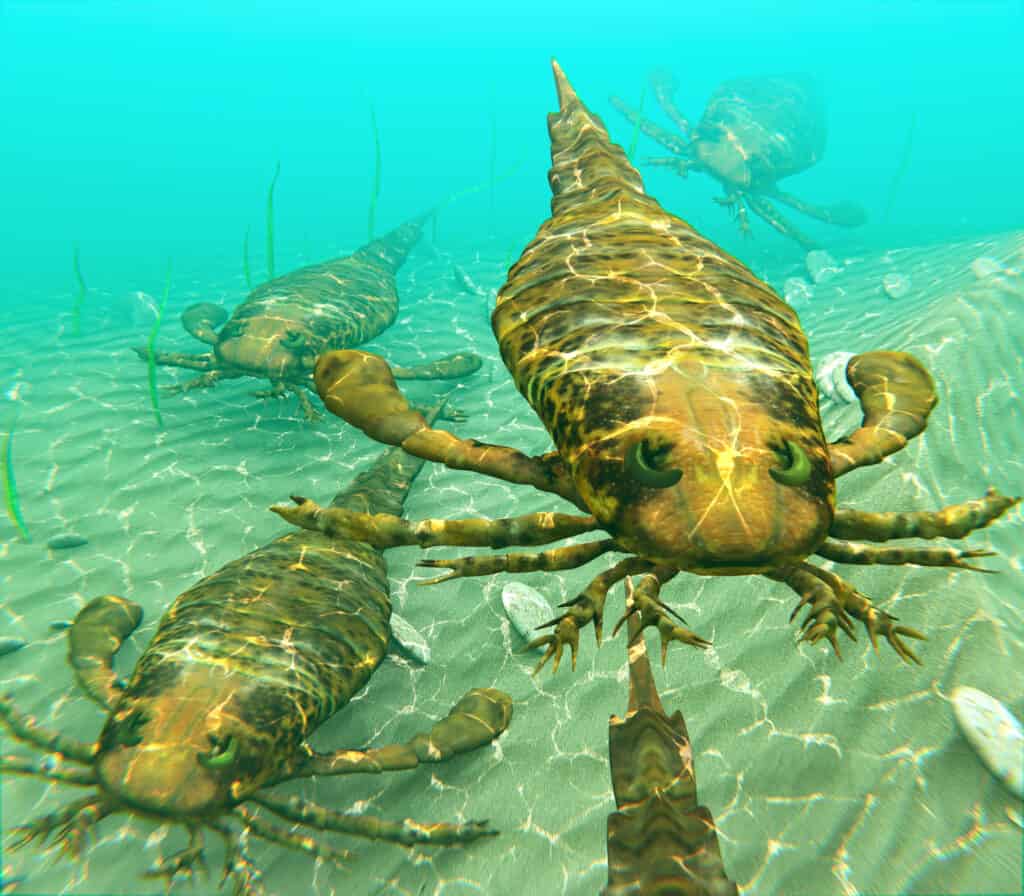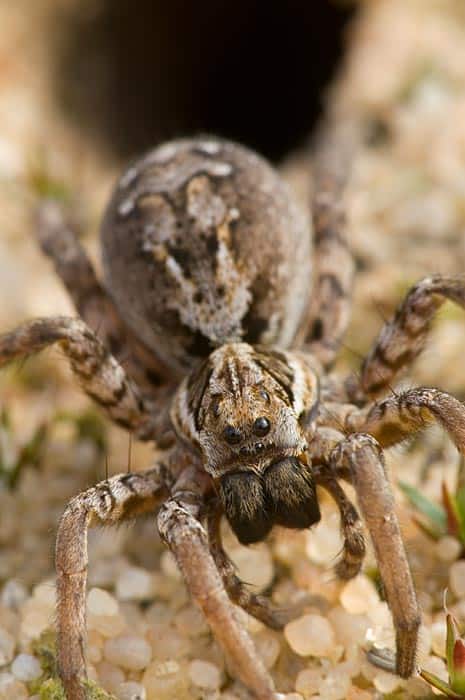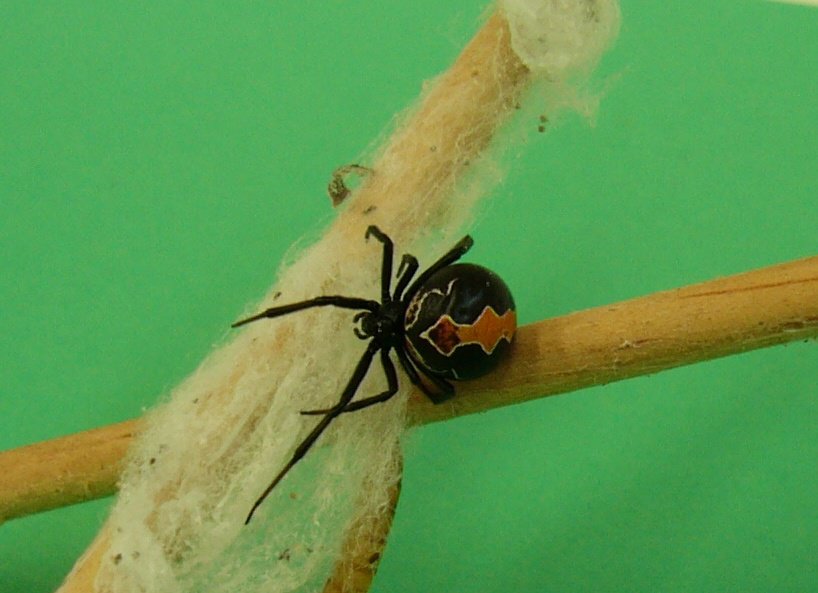Spiders have roamed the planet for millions of years. They evolved from creatures that emerged from the oceans into the eight-legged arachnids we know today. Along the way, spider species have become extinct and many species are on today’s endangered list. Let’s take a look at 5 extinct spiders.
But first, what is a spider?
What Is A Spider?
Spiders are land-based arachnids. They have eight legs, fangs called chelicerae that inject venom, and spinnerets that produce silk for webs and wrapping up prey. They are predators with the exception of Bagheera kiplingi which is herbivorous. Experts think the world’s spiders eat up to 800 million tons of prey each year.

Bagheera kiplingi is the only herbivorous spider in the world
©Joyce LCY/Shutterstock.com
Attercopus Fimbriungus
Attercopus fimbriungus is an extinct spider and the only known member of its genus. Its Devonian era fossil (that’s 390 million years ago) was found in the Panther Mountain formation in modern-day New York.
Although this is a genus of arachnid, it’s not truly a spider, instead belonging to spider-like animals that were close to the origin of modern spiders. It dates to around 150 million years before the dinosaurs emerged. Attercopus fimbriungus could produce silk, but it had a separate abdomen like a scorpion and didn’t have spinnerets. It was probably a ground-dwelling predator that lived in forests hunting cockroaches, silverfish, and millipedes.
Paleontologists think it’s one of the most primitive spiders that used silk to wrap up prey rather than spinning a web. This research discusses the origins of spider spinnerets and evolution of arachnids. It puts Attercopus fimbriungus near the beginning of the evolutionary process.
Mongolarachne Jurassica

There have been discoveries of both male (left) and female (right) Mongolarachne spiders
© – License
This hand-sized extinct spider roamed the Jurassic world. A recent fossilized specimen was found in China’s Inner Mongolia preserved in volcanic ash.
The discovery was male and bigger than the female that was found previously. Paleontologists suggest this is unusual because female spiders are usually larger than their male counterparts.
It’s likely Mongolarachne jurassica sits at the midpoint between primitive spiders and modern ones because it was able to spin webs. It was found in an area that was near a lake and forest so experts think it preyed on forest insects.
Centrobunus Braueri
Centrobunus braueri is an extinct species of Opiliones arachnid. It was endemic to the Seychelles island of Mahe.
It was first found in 1894, but never found again despite efforts to locate it in the wild. Very little information exists, but experts think habitat destruction and the introduction of the cinnamon tree caused its extinction. It was formally declared extinct in 2014.
Centrobunus braueri is not the only Mahe spider to suffer extinction. Alongside it, Pleorotus braueri, Sitalcicus gardineri, Peromona erinacea, Metazalmoxis ferruginea, Stipax triangulifer, and Thomasettia seychellana have gone extinct there since the 1800s. Experts think these similar spiders were all victims of habitat erosion.
Waimea Sheet Weaver
This sheet weaver was only found once in the late 19th century, by the famous entomologist R.C.L Perkins. The specimen was captured in the Hawaiian Islands and labeled simply ‘Waimea’. There’s not a lot to go on, but it may mean the locality of Waimea on Kaua’i Island.
Megarachne

Megarachne was misidentified as a giant extinct spider, but is actually a type of late carboniferous sea scorpion.
©Aunt Spray/Shutterstock.com
This mega spider was claimed to be the largest ever spider at over a foot long. Argentinean Paleontologist Mario Hunicken found it in 1980 embedded in 300 million-year-old Argentinian rock.
Its sheer size gave rise to the name Megarachne servinei, (that’s ancient Greek for ‘great spider’) and it’s no surprise that museums and TV producers went crazy for it. However, in 2005 the fossil was re-examined. It was not a giant spider after all, but a medium-sized sea scorpion from the eurypterid arthropod family. Part of the problem was that its fossil was found in a freshwater area, not a marine area that sea scorpions were thought to inhabit.
But this doesn’t take away from its impressive appearance. Megarachne had shovel-type jaws and a shield across its abdomen. It was a ferocious predator that sifted through soft sediments for invertebrates in the late carboniferous period.
Despite its re-assignment, this giant sea scorpion had to retain the name megarachne – but don’t be fooled. This is not one of the giant extinct spiders!
Great Fox-Spider

The great-fox spider was thought extinct, but was recently discovered on a military base.
© – License
Alopecosa fabrilis is the great fox-spider found across Europe. It’s a species of wolf spider from the Lycosidae family that hunted at night with eight black eyes and incredible speed. It was presumed extinct since the 1990s, but made a comeback when one was found in 2020 on a UK military training site.
Both sexes are pale cream with black stripes, but the females are the largest measuring up to two inches long. Great fox-spiders prefer to burrow in sandy soil where they pounce on beetles, flies and other spiders.
It’s listed as critically endangered, so this spider is still at risk of extinction.
What Are Some Critically Endangered Spiders?
Whilst they’re not extinct spiders yet, here are three critically endangered spiders at risk of disappearing forever.
Kauai Cave Wolf Spider

The Kauai cave wolf spider lives in just a single cave.
©Gordon Smith, Public domain, via Wikimedia Commons
The Kauai cave wolf spider (Adelocosa anops) is endemic to Kauai, Hawaii. There are only 16-28 left in a single cave. They have evolved to live in the dark and have no eyes. Food is scarce and they reproduce infrequently. Although they’re one of the largest cave dwellers at just over three inches they are critically endangered.
Katipō

The Katipo spider has been doximated across New Zealand.
©jesscostall / Creative Commons 2.0 – License
Katipo (Latrodectus katipo) lives in New Zealand. It’s related to widow spiders and its name means ‘night stinger’. Its burrow and tree habitat is being lost to forest clearance, and the introduction of non-native spiders that prey on them has decimated the wild population down to a few thousand.
Spruce-fir Moss Spider
The spruce-fir moss spider (Microhexura montivaga) lives in the high-elevation forests of eastern Tennessee and North Carolina. It’s highly vulnerable to wind and sun that dries out its body. To keep itself moist, it hides in damp moss. In order to safely hunt it builds a tube web between spruce-fir trees and rocks so it can prey on tiny insects.
This spider resembles a tarantula but it’s tiny at 0.14 inches. However, it doesn’t win the world’s smallest spider prize. That belongs to the patu digua of Colombia at a minuscule 0.015 inches.
Spruce-fir moss spiders have been listed as endangered since 1973.
So here we have 5 extinct spiders plus a ‘red-herring’ sea scorpion, and a ‘Lazarus’ spider that emerged 30 years after it was presumed extinct.
Even if you don’t like them, spiders are incredible creatures that deserve their place on Earth. Did you know they are the primary controllers of insects? Without them, there would be real threats to our food supply.
The photo featured at the top of this post is © OBX Wildlife/Shutterstock.com
Thank you for reading! Have some feedback for us? Contact the AZ Animals editorial team.






